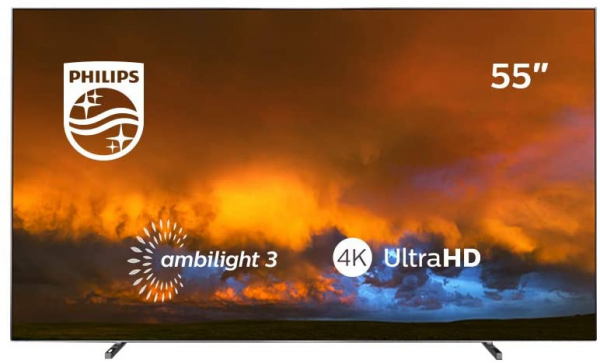Philips
Philips 55OLED804: Oled and Ambilight TV switches to Android 9.0
Aprox. 1349€
See specificationsThe Philips OLED804 television broadly incorporates the characteristics of the OLED803, but it opts for a more powerful processor and ships the recent Android Pie 9.0.
Positive points
Image quality.
Contrast.
Viewing angles.
Best compensation engine on the market.
P5 processor still as efficient.
Reactivity.
The originality of the Ambilight system.
The possibilities offered by Android TV (applications, Chromecast, etc.).
Bad points
Delay in display a little higher than among competitors.
Basic cable routing system.
Consumption.
Our review
Presentation
This model therefore embeds the same 10-bit 100 Hz Oled panel as its predecessor. Displaying an Ultra HD definition of 3 840 x 2 160 px, this panel always covers 99% of the DCI-P3 color space and ensures a maximum brightness of around 750 cd / m². The television retains its original Ambilight ambient lighting system and the Android TV system, which is now available in version 9.0. This model includes the third version of the Philips P5 processing processor and a new, more powerful ARM processor to run Android. The design is identical to that of the Philips OLED803, still as sleek and minimalist.
The Philips 55OLED804 is currently sold for around € 1,800, a fairly reasonable launch price for an Oled TV. It is also available in a 65-inch version (Philips 65OLED804) for € 2,800.
All the brightness and colorimetric measurements mentioned in this article were carried out with a SpectraCal C6-HDR probe and the CalMAN Ultimate software.
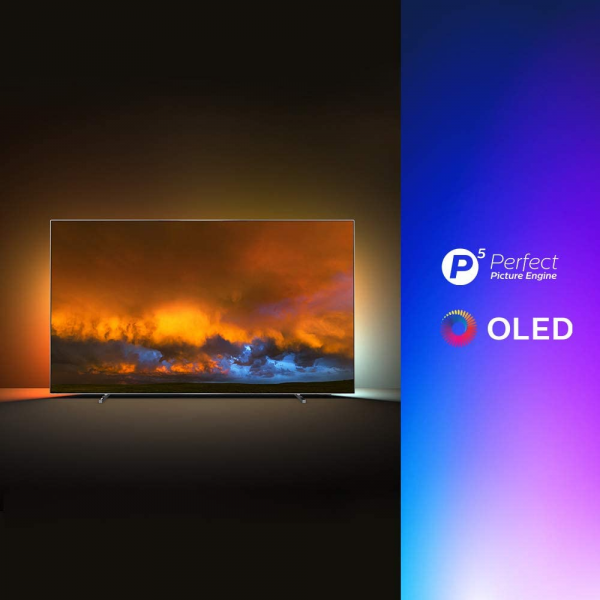
Image quality
No surprise on the side of the Oled panel since it is the same as those of almost all Oled TVs since the end of 2018. There are four sub-pixels white, blue, red and green. The blue and green sub-pixels are in the form of fairly thin sticks while the red sub-pixel is larger in order to support a higher brightness peak while maintaining a color temperature close to 6,500 K. The sub-pixel white - specificity of LG tiles - increases the brightness of the tile by limiting the marking phenomenon. Oled technology always offers the best viewing angles on the market, with a 45 ° loss of brightness limited to 21%. Obviously, there is no variation on black, the sub-pixels being extinguished individually.
Film mode provides the best color rendering. The average delta E is measured at 1.8, a value well below 3, a threshold below which the eye can no longer distinguish colorimetric drifts. With the exception of grayscale, no hue exceeds this value of 2. We can consider that this television displays colors perfectly faithful to those sent by the source.
As is often the case with Oled televisions, the gamma curve flawlessly across the spectrum and shifts to the reference value (2,4).
The temperature curve is fairly stable over the entire spectrum and the average measured at 6.310 K is close to 6.500 K of the video standard. In the end, the image is slightly too hot, but it remains in a very good average.
The contrast of Oled TVs is always considered to be infinite. Indeed, even with a white calibrated at 150 cd / m², black is measured at only 0.0049 cd / m² (threshold below which our probe cannot measure black). This contrast is still as impressive and allows you to enjoy all the nuances, even in complete darkness.
The Philips Perfect Picture Engine scaling engine gains even more precision with the third generation of the Philips P5 video processor. If cinema enthusiasts go their way, aficionados of image enhancements will be won over by the performance of this treatment, which transforms an image from an HD or Full HD source into an Ultra HD image with a stunning level of detail. In Film mode, this processing is disabled for much smoother scaling, thus avoiding artifacts. Cinema fans will however be amazed by the performance of the P5 Perfect Natural Motion motion compensation engine. Philips is clearly at the forefront in this area and shows that it is possible to produce perfectly sharp images in motion without forcing fluidity. The Perfect Clear Motion engine eliminates blurring behind moving objects, resulting in a perfectly sharp image. Only Panasonic can do so well on its Oled TVs.
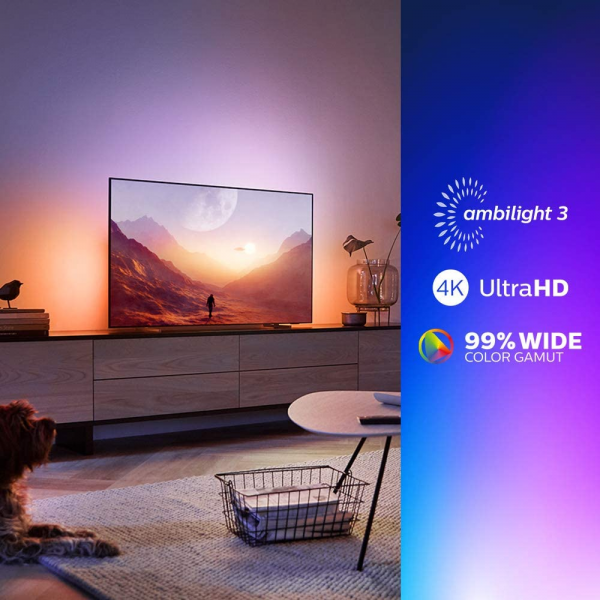
HDR
This Philips TV is one of the few models on the market to be compatible with Dolby Vision and HDR10 +, in addition to the classic HDR10 and HLG. Only Panasonic also offers televisions compatible with these four HDR formats.
With a maximum HDR signal of 1,000 or 10,000 cd / m², the Display Tone Mapping used by Philips behaves quite well. If it follows the reference EOTF curve perfectly (in yellow), it cannot avoid clipping around 75% of brightness, ie the maximum capacities of the slab. We prefer that the manufacturer smooths the signal in order to be able to appreciate all the details of the image or at least that he offers an option allowing to choose the preferred mode.
We measured the brightness peak at 728 cd / m² in HDR10 on a 10% window in Film mode, and therefore a perfect temperature close to 6,500 K. This brightness is classic for an Oled TV. We did not find the brightness above 800 cd / m² that we had measured on the Philips OLED803. Recall that the Panasonic GZ2000 today offers the best brightness peak on an Oled TV with nearly 1000 cd / m². High-end LCD TVs with their brightness peak above 2,000 cd / m² (Sony 65ZF9 or Samsung 75Q900R) are often more impressive, but are affected by the very annoying blooming (halo effect around light objects on a black background). If the peak of brightness cannot compete with that of the best LCD televisions, it is especially the very deep blacks which allow a beautiful dynamic of the image on Oled televisions.
In HDR Film mode, we measured an average Delta E of 2.8, always less than 3, but several colors exceed a Delta E of 3.
The 70% coverage of Rec.2020 is classic for an Oled TV. This value is quite low, but it is one of the best on the market. In fact, only a few televisions manage to display more than 70% of Rec.2020, including the Oled models and some high-end LCD televisions.
Fortunately, things are getting better with the coverage of the DCI-P3 color space which reaches 97%, that is to say almost all the colors used by the cinema industry for Ultra HD films.
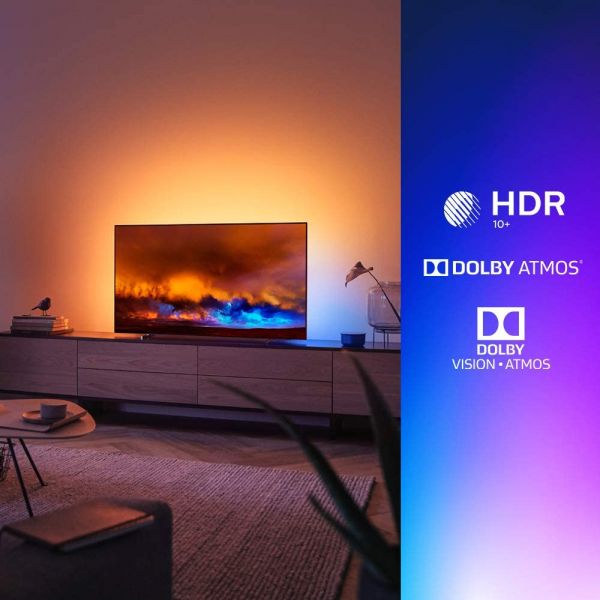
Video games
Philips has slightly improved the responsiveness of its Oled TV, but not enough to keep up with the best competitors. We measured the display delay at 32 ms, compared to 36.8 ms on last year's OLED803. The Philips 55OLED804 thus displays a delay in the display of two images (at 60 Hz) relative to the source. This is more than the LG Oled Ultra HD televisions which go down to 13 ms (LG 65C9) which are the most reactive on the market, but also more than the latest Qled models from Samsung which go down to 15 ms. Panasonic also does better on its Oled TVs with an input lag limited to 21 ms. Fortunately, there is no persistence since the Oled technology benefits from an instant response time, which results in very few blurring effects behind moving objects.
As long as we take the trouble to make some adjustments by setting the temperature to Warm (Configuration> Image> Advanced> Color> Color temperature) and the gamma to +4 (Configuration> Image> Advanced> Contrast> Gamma), the picture is generally faithful in Game mode. We measured an average Delta E at only 2.8 in HDR and 4 in SDR. On this point, it is much better than last year.
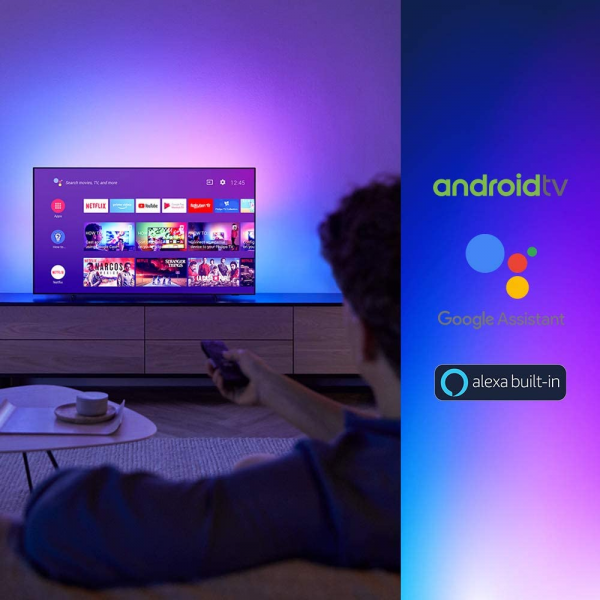
Clouding
With Oled technology, each pixel generates its own light and therefore its own heat. The thermal camera thus distinguishes the elements of the Android TV interface. [/ Media]
Oled technology makes it possible to manage each pixel individually without using a light distribution filter: there is therefore no clouding. We measured the average difference in white homogeneity over the entire 55-inch panel at only 6%. This very good result is explained by the use of Oled technology, which results in few variations on white. Recall that the eye begins to see a difference from 20% average deviation.
We are now talking about the marking phenomenon in the clouding part which is one of the disadvantages of Oled TVs. We have never faced this problem and the tests we have carried out have not shown any marking for a short period. Long-term tests have shown that the marking of modern Oled tiles is limited during everyday use. On the other hand, continuous news channels displaying banners with saturated colors (red, blue or green) can clearly be a problem, especially when the brightness is pushed to the maximum. This risk exists and cannot be totally overlooked. Remember that you must switch off the television using the remote control and that it is not recommended to disconnect it completely from the power. Indeed, during its standby, the television performs maintenance operations on the screen in order to preserve uniformity and precisely to avoid marking problems.
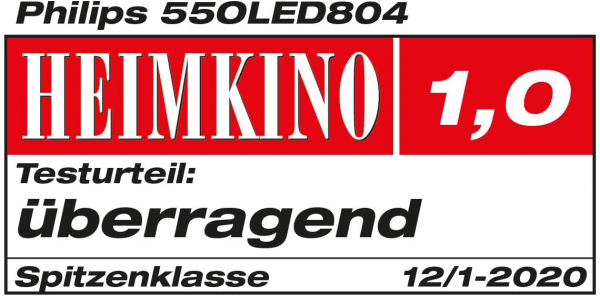
Ergonomics
The Philips 55OLED804 uses the sleek design of the Philips 803 with very thin feet and a panel very close to the ground, which immediately prohibits the use of a sound bar that would mask part of the image. The design is successful and the finishes are particularly neat.
Like most Oled TVs, the edges of the screens are thin and as we can still see, the finishes are exemplary.
Unsurprisingly, the anti-glare filter used by Philips is identical to that found on other Oled TVs on the market. LG Display - which supplies Oled tiles to all manufacturers - has not yet improved its copy. The anti-reflective treatment manages to dilute most of the light reflections. If the result is among the best on the market, it does not match that of high-end TVs from Samsung, like the 65Q85R, which remain the benchmark in the field.
This 55 inch TV is very comfortable on our reference TV stand which measures 160 x 40 cm. If the television is content with a thickness of 5 cm, the dimensions on the TV stand are always linked to that of the legs which are limited here to a depth of 23 cm.
The back of the TV is classic. We find the power supply on the left, the 30 W woofer in the center and the connection on the right. Philips is satisfied with a rilsan collar to fix the cables. It's better than nothing, but it shows a little compared to the finishes of the TV.
The connections are distributed in two places. On the side, there are three HDMI 2.0a inputs (Ultra HD 60 fps, HDR, HDCP2.2), two USB ports including a USB 3.0, a PCMCIA port (CI + common interface) and a headphone output. At the rear, an additional HDMI input, optical digital audio output, Ethernet port, component input (via a supplied adapter) and rake and satellite antenna connectors. The TV has a dual tuner DVB-T / T2 / T2-HD, DVB-S / S2 and DVB-C. It also has 802.11a / b / g / n / ac Wi-Fi, as well as Bluetooth 4.2 for connection with a wireless audio device (headphones or speaker).
Exclusive to Philips televisions, the Ambilight system projects the colors of the image on the screen onto the rear wall, but not only. Over the years, Philips has improved it by adding many modes offering to exploit it differently. The ambient light can thus vary depending on the sound (useful when the image is fixed, with Deezer or Spotify, for example). The Ambilight can also be integrated into a Philips Hue environment - Philips connected bulbs - to contribute to the ambiance of the room. It is also possible to choose personalized atmospheres that have nothing to do with the content (red, green, blue or white) or even display the flag of your favorite team during the World Cup.
The Philips 55OLED804 has Android TV in its latest version (9.0). This system uses the new interface launched by Android 8.0. It is a little less intuitive at first, but more effective later. The lines directly display the content of the most used applications (Netflix, YouTube, Molotov TV, myCanal, SFR Sport, etc.). The Android TV system is one of the most complete on the market and especially the one with the most applications, but not all of them are optimized for use on a television. In addition, the integrated Chromecast allows you to receive and display a video stream sent from a smartphone, tablet or computer. The MediaTek MT5596A processor and its 2 GB of RAM from the Philips OLED803 are replaced by a MediatTek MT5597 and 3 GB of RAM for better system responsiveness. We will always avoid greedy software, especially games, but this processor is powerful enough to properly manage video applications.
As with all Android TVs, the first boot takes longer. It takes about 45 seconds here. Fortunately, the TV comes out of standby in 5 seconds, while consuming less than one watt in standby. In any case, it is much longer than Tizen systems from Samsung or WebOS from LG, which start up in less than 5 seconds. Finally, as often, the standby is instantaneous.
This television is supplied with a single very complete remote control which allows access to all the functionalities, but which is sometimes a little bulky. In addition, the use of the keys is not very intuitive. On the back of the remote control, there is a full keyboard, convenient for entering passwords. Finally, a single button is backlit, that of the Ambilight ...
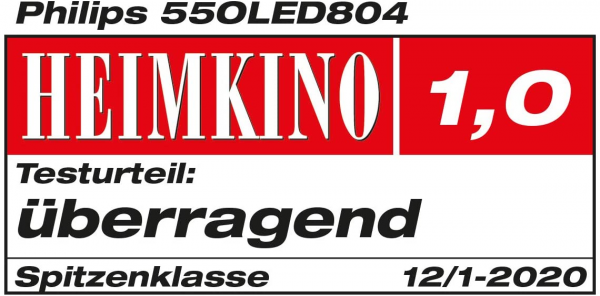
Audio
The sound system of the Philips 55OLED804, consisting of two 10 W tweeters and a 30 W woofer - located at the rear - delivers good sound, well above average TVs. We particularly appreciate its ability to descend into low mids. It delivers a clear and sufficiently powerful sound. The most demanding will obviously turn to a dedicated sound bar.

Consumption
Consumption is still the weak point of Oled TVs compared to the best LCD TVs. We measured consumption at 100 W on our target with a white set at 150 cd / m². Relative consumption thus reaches 119 W / m², which is higher than the average of the televisions tested (around 100 W / m²) and therefore results in a score of only 2. This Philips TV consumes more than its main competitors. The Panasonic TX-55FZ800 is content for example with 81 W, or 97 W / m², about as much as the LG 65C9 - 65 inches - and its 99 W, or 85 W / m². This is far from the Sony KD-65XE8505, the category record holder with its 56 W / m². Standby consumption is always less than 1 W. Note that consumption increases by ten watts with the Ambilight system activated.
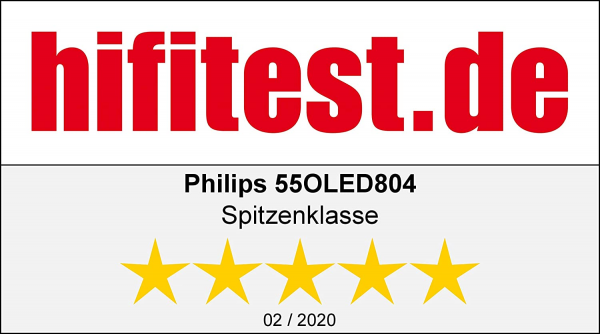
Conclusion
The Philips 55OLED804 is a great Oled TV. Whether SDR or HDR, it displays a perfectly calibrated image that will delight fans of movies and TV series. The P5 processor - one of the best on the market - offers the best in scaling and motion compensation, and Oled technology is still unmatched in terms of contrast, responsiveness and viewing angles. Oled televisions are numerous and our selection criteria are tightening. This model just misses the fifth star because of a delay in the display higher than that of the competitors and an increase in consumption. Fortunately, it is the only one to have the Ambilight system, a singularity that can make the difference for those who are looking for an Oled TV that goes a bit off the beaten track.
Specifications

